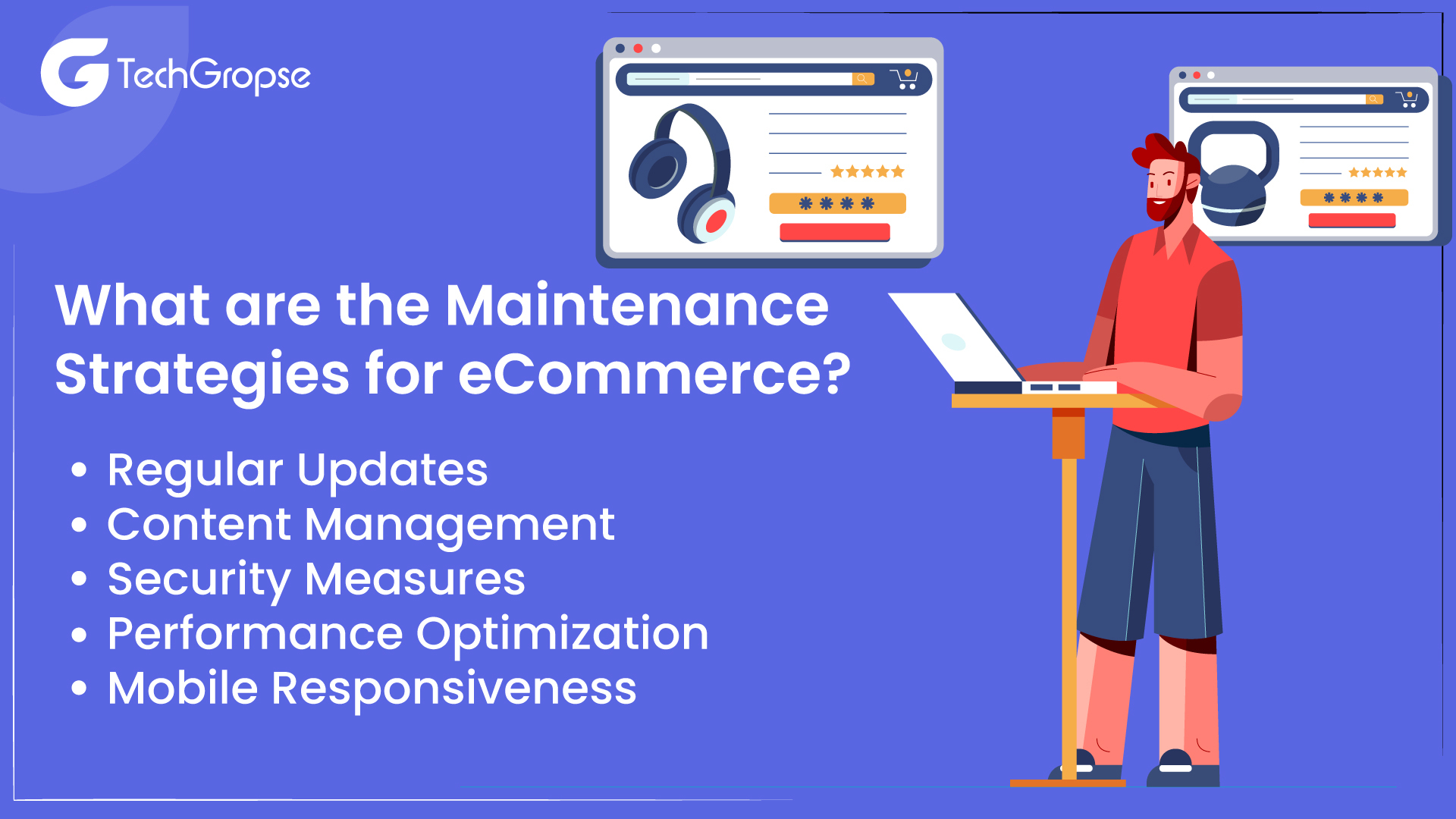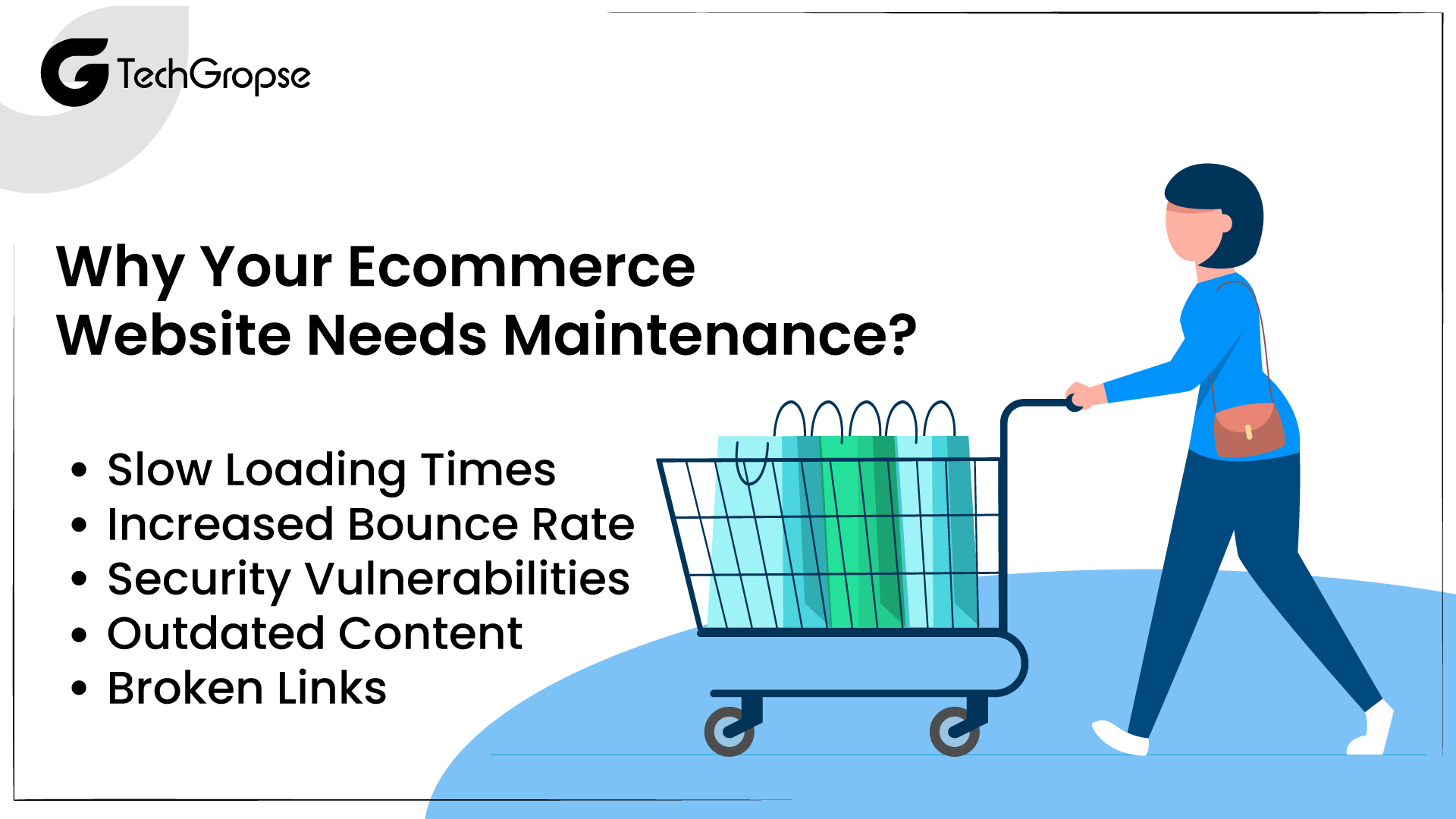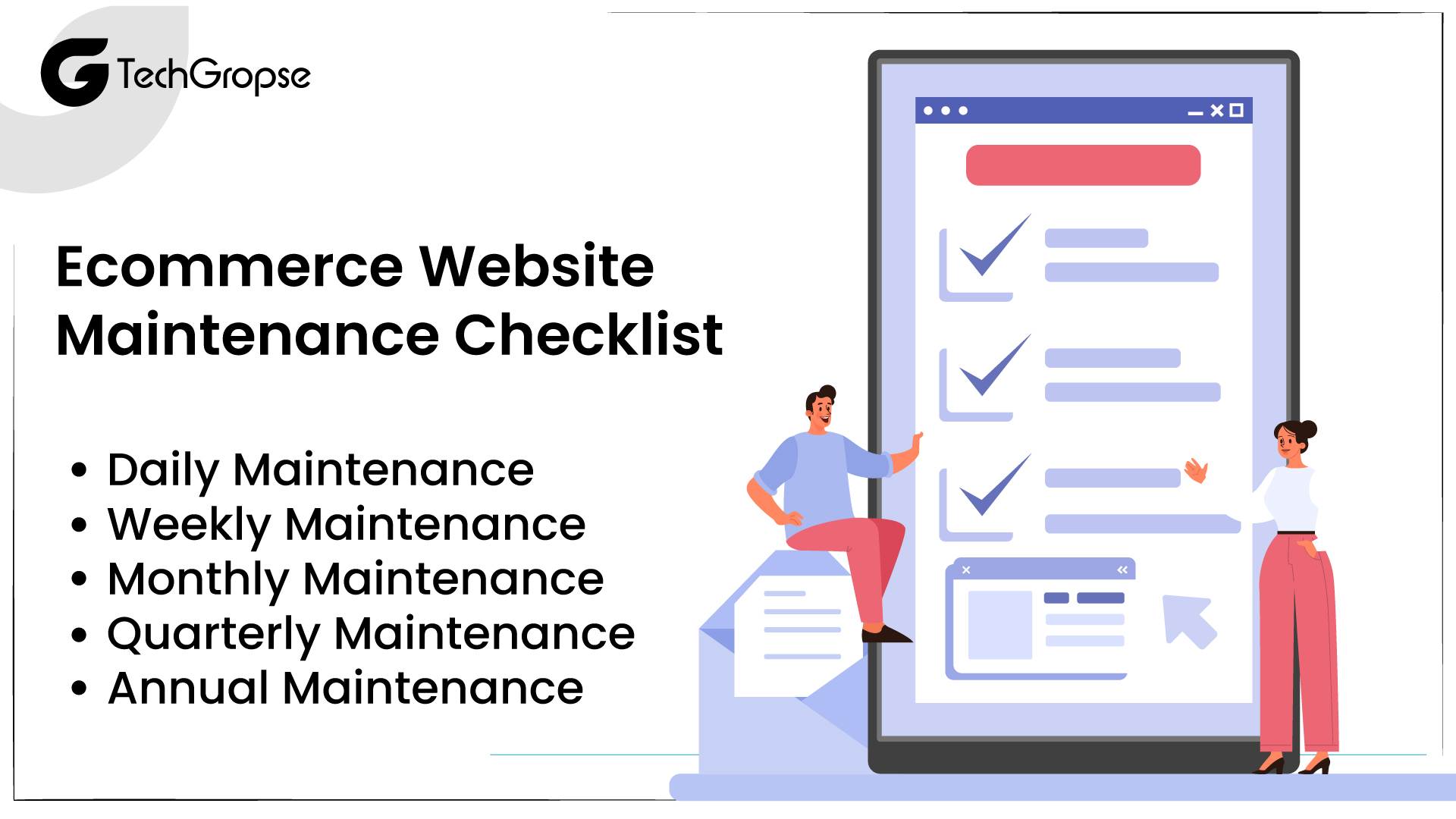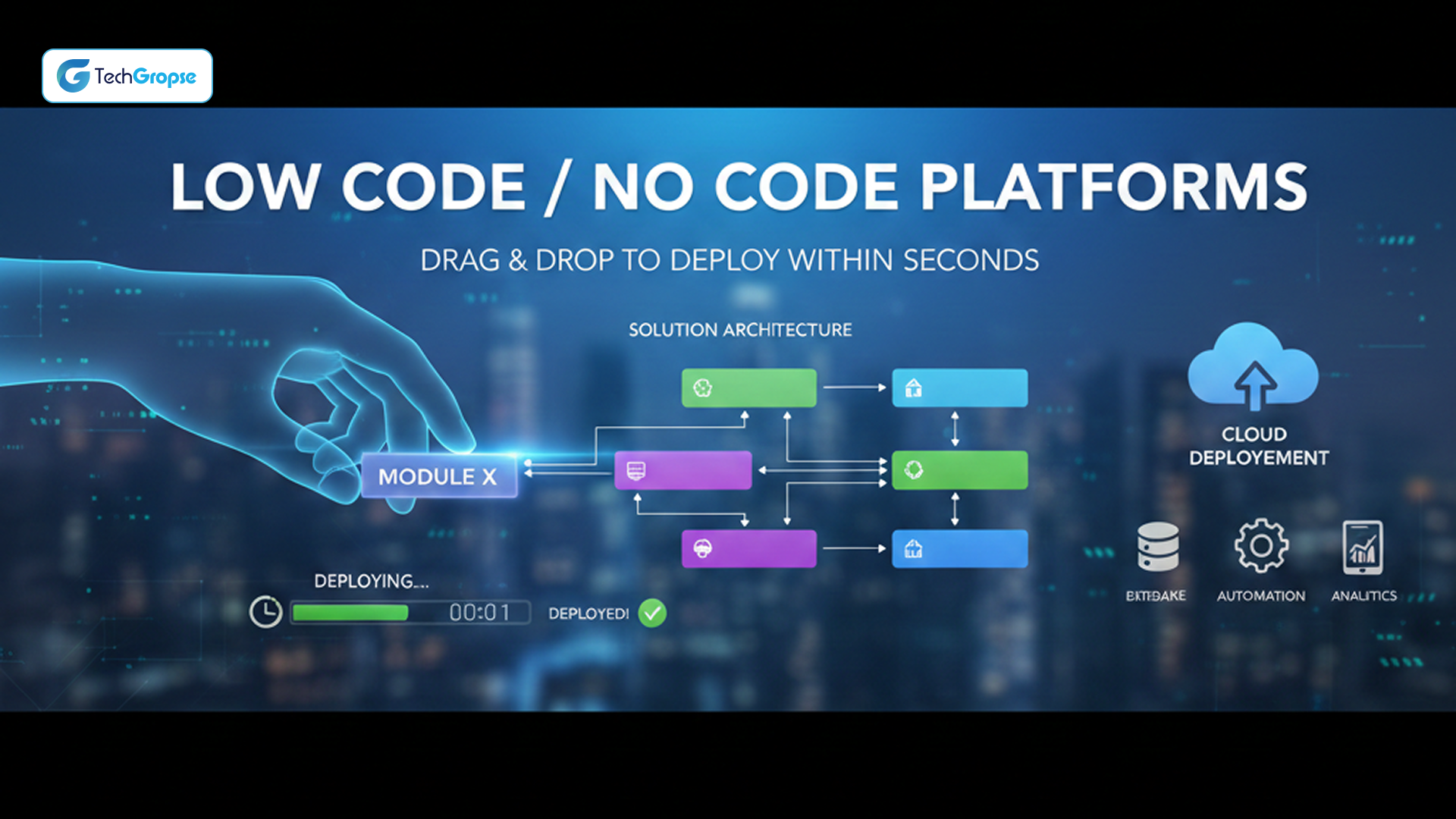| Reliable, cost-effective ecommerce website maintenance to ensure smooth operations, security, and peak performance for your online business. So, maintain, optimize, and elevate Your E-Commerce experience with us. |
It seems like everyone these days is buying things online. Can you believe that by 2021, there will be over 230 million people in the United States shopping digitally? That’s what eMarketer predicts.
It is not surprising though. We have the whole internet at our fingertips, filled with all types of things to buy. Especially after COVID hit and we had to stay inside, online shopping became more popular.
Forbes even says that in May 2020, people spent 77% more money in online stores compared to previous years.
But here is the thing, just having an amazing website and putting up new products is not enough for a business. Just like anything else you do, an online store needs regular maintenance.
Think of it like moving into a new house. At first, everything is nice and clean. But over time, dirt starts to build up, the washing machine stops working properly, and the wardrobe door won’t close properly.
But because you care about your house, you clean it, fix the washing machine, and repair the door. It’s the same with an online store, you have to take care of it and keep it running smoothly.
Ecommerce has become an essential part of the modern business landscape, providing businesses with a platform to reach a global audience and sell products or services online. However, just having an ecommerce website is not enough to ensure success.
Like any other digital asset, ecommerce websites need regular maintenance to stay functional, secure, and competitive.
Let’s discuss an ecommerce website maintenance company, ecommerce website maintenance, we will explore the importance of regular updates, security measures, performance optimization, content management, and more.
What is eCommerce Website Maintenance?
E-commerce website maintenance is a vital ongoing process essential for the smooth operation and success of online businesses. It involves a series of tasks to ensure that an e-commerce website remains secure, up-to-date, and fully functional.
Taking care of your website is not just about picking new colors or saying something is sold out. It’s about making awesome things for people to read, protecting them from sneaky hackers, and making sure the marketing team is doing their thing.
Ecommerce website development company help to update the e-commerce platform, plugins, and extensions for security and functionality improvements is crucial. Security is a top priority, involving regular audits to identify vulnerabilities, the renewal of SSL certificates, and the implementation of firewalls and malware protection.
What is the Role of Ecommerce Website Maintenance
Are you an online shop owner? Just like a car needs regular maintenance to keep running smoothly, your ecommerce website requires some TLC too. Website maintenance plays a crucial role in keeping your online store up and running, ensuring a seamless shopping experience for your customers.
If you want to build ecommerce website, here is a deeper understanding of the role of website maintenance in e-commerce:
- Security
- Content Updates
- Software Updates
- Performance Optimization
- Mobile Responsiveness
- Custom Development
- SEO and Analytics
- Backup and Recovery
So, let’s dive into the world of ecommerce website maintenance and learn how to keep your digital storefront in tip-top shape.
What are the Maintenance Strategies for eCommerce?

Maintaining an e-commerce website is essential to ensure its functionality, security, and competitiveness in the online marketplace.
An ideal website development company follows unique maintenance strategies for e-commerce websites:
1. Regular Updates
- Platform Updates: Keep your e-commerce platform, including the core system and plugins, up to date with the latest versions. It ensures that you have access to the latest features and security updates.
2. Content Management
- Product Updates: Regularly update product listings, descriptions, prices, and images to keep your offerings current and engaging for customers.
- Content Audits: Periodically review and audit website content for accuracy, relevance, and SEO optimization.
3. Security Measures
- Regular Security Audits: Conduct regular security audits to identify vulnerabilities and threats.
- SSL Certificate Renewal: Maintain a valid SSL certificate to secure customer data during transactions.
- Firewall and Malware Protection: Implement firewalls and malware protection to safeguard against cyber threats.
4. Performance Optimization
- Speed Optimization: Optimize website loading times, image compression, and code to enhance performance.
- Database Tuning: Regularly clean and optimize your database to prevent slowdowns.
5. Mobile Responsiveness
- Ensure your website is responsive and compatible with various devices and screen sizes, providing a seamless user experience across all platforms.
6. Cross-Browser Compatibility
- Test your website on different web browsers to guarantee it functions correctly and consistently for all users.
7. SEO and Analytics
- Implement and maintain SEO best practices to improve search engine visibility.
- Regularly monitor website analytics to gain insights into user behavior and performance.
8. Backup and Recovery
- Perform regular backups of your website’s data and files to ensure data recovery in case of loss or unexpected issues.
9. Bug Fixes
- Identify and address technical issues, glitches, and bugs that may affect the functionality or user experience of your website.
10. Emergency Support
- Have a plan in place for emergency support to address critical issues promptly like website downtime or security breaches.
What Will Occur if You Don’t Maintain Your Ecommerce Website?
Neglecting to possess your e-commerce website can lead to a range of negative consequences, potentially harming your online business in different ways.
Here are some of the potential outcomes of failing to maintain your e-commerce website:
- Website Downtime: Outdated software, technical issues, or security breaches can cause website downtime, which disrupts the shopping experience for customers and results in lost sales and a damaged reputation.
- Loss of SEO Ranking: Search engines reward websites that are well-maintained, fast, and secure. Neglecting maintenance can lead to a drop in search engine rankings, reducing organic traffic and potential customers.
Declining Sales:
- Legal and Compliance Issues: Neglecting to update your website to meet legal and regulatory requirements, such as GDPR or CCPA, can result in legal consequences and financial penalties.
- Data Loss: Without proper backup procedures, you risk losing essential website data, customer records, and transaction history. Data loss may be a major thing for your business.
- Competitive Disadvantage: Competing e-commerce websites that invest in maintenance and improvements will likely outperform and outcompete your site.
Why Your Ecommerce Website Needs Maintenance?

A web development company identifying when your e-commerce website requires fine-tuned maintenance is crucial to prevent issues and ensure the optimal performance of your online store.
Here are signs that indicate your e-commerce website may need maintenance:
- Slow Loading Times: If your website is slow to load, it can deter potential customers. Slow loading times can be due to large images, outdated code, or server issues.
- Increased Bounce Rate: A rising bounce rate, where visitors leave your website quickly after arriving, can be a sign of poor user experience or unresponsive design.
- Security Vulnerabilities: Frequent security breaches or signs of potential vulnerabilities, such as suspicious activity, should trigger immediate attention and security updates.
- Outdated Content: If product descriptions, prices, or images are outdated, your website may lose credibility and miss sales opportunities.
- Broken Links: As we are aware broken links can have a negative effect on SEO and user experience. Regular checks can help identify and fix them promptly.
- Unresponsive Design: If your website is not mobile-responsive and doesn’t adapt to various screen sizes, you may lose mobile users.
- High Cart Abandonment Rate: An increasing rate of customers abandoning their shopping carts can signal issues in the checkout process or website trustworthiness.
- Decreased Search Engine Rankings: A drop in search engine rankings can be due to outdated SEO practices, slow loading times, or other technical issues.
- Technical Errors: Frequent technical errors or website crashes, including 404 errors or 500 internal server errors, need immediate attention.
- Outdated Software and Plugins: Using outdated e-commerce platform versions or plugins can lead to security vulnerabilities and decreased functionality.
- Lack of Analytics Insights: If you’re not using analytics tools to track website performance and user behavior, you may miss valuable insights.
- Decreased Conversion Rate: A declining conversion rate, where fewer visitors make purchases, may indicate issues with the checkout process or product listings.
- Compliance Concerns: Changes in data protection regulations or e-commerce laws may require updates to your website to maintain legal compliance.
- High Maintenance Costs: If your maintenance costs are continually rising, it may be a sign that your website’s complexity or issues need to be addressed.
- Customer Complaints: Pay attention to customer feedback and complaints. Repeated issues or negative feedback can highlight areas in need of improvement.
- Expired Domain or Hosting: Ensure your domain registration and hosting are up to date to prevent your website from going offline.
- Competitive Lag: Falling behind competitors in terms of design, features, or user experience can indicate a need for an update.
You can hire web developers to regularly monitor your e-commerce website for these signs and proactively addressing them through fine-tuned maintenance can help ensure your online store remains competitive, secure, and user-friendly.
Types of Ecommerce Website Maintenance
These three types of e-commerce website maintenance tasks are essential for ensuring a secure, user-friendly, and competitive online shopping experience. Neglecting any of these areas can lead to security vulnerabilities, a decline in website performance, and a loss of potential customers.
Consistent maintenance across these categories is crucial for the long-term success of your e-commerce business.
1. Security Maintenance
Security is paramount in e-commerce due to the sensitivity of customer information and financial data. E-commerce websites are frequent targets for hackers.
Key Tasks
- Regular security audits to identify vulnerabilities.
- Installing security patches and updates to protect against threats.
- Implementing firewalls, intrusion detection systems, and malware protection.
- Importance: Preventing security breaches, data theft, and maintaining customer trust.
2. Marketing Maintenance
It is essential for driving traffic to your website and ensuring it ranks well on search engines. It involves keeping content fresh and relevant.
Key Tasks
- Creating new content in various formats (e.g., SEO articles, blogs, social media posts, videos).
- Utilizing analytics tools like Google Analytics to fine-tune content and understand the audience.
- Implementing digital marketing strategies to reach and engage with your target audience.
- Importance: Attracting visitors, improving search engine rankings, and staying relevant in a competitive market.
3. Storefront Maintenance
Your online storefront is the first impression customers have of your business. It is important to make it user-friendly and visually appealing.
Key Tasks
- Designing an attractive and user-friendly landing page.
- Organizing and categorizing products for easy navigation.
- Using creative and engaging elements to capture the essence of your brand.
- Importance: Creating a positive first impression, building trust, and conveying the appeal of your products or services.
What is an Ecommerce Website Maintenance Cost?
Your breakdown of e-commerce website maintenance costs for small, medium, and large companies provides a helpful overview of the typical expenses associated with maintaining an online store.
However, it is important to note that these costs can vary based on factors such as your specific platform, hosting provider, and the range of services you require.
Here is a summary of the average costs you have outlined:
Maintaining a Small E-commerce Website
| Aspect | Cost (Monthly or Estimated) |
| Hosting Costs | $11.95 |
| Domain Registration and Renewal | Approximately $1.25 per month |
| Backups and Migrations | Free or platform-dependent |
| Security | Free or included in hosting |
| Additional Site Plugins | $10 |
| SSL Certificates | Free or included in hosting |
Maintaining a Medium-Sized E-commerce Website
| Aspect | Cost (Monthly or Estimated) |
| Hosting Costs | $19.95 |
| Domain Registration and Renewal | Approximately $1.25 per month |
| Backups and Migrations | Approximately $7.40 |
| Security | Around $17 |
| Site Plugins | Around $20 |
| SSL Certificates | Free or included in the hosting |
Maintaining a Large E-commerce Website
| Aspect | Cost (Monthly or Estimated) |
| Hosting Costs | $200 |
| Domain Registration and Renewal | Approximately $1.25 per month |
| Backups and Migrations | Free or platform-dependent |
| Security | Approximately $25 |
| Site Plugins | Around $40 |
| SSL Certificates | Free or included in the hosting |
Ecommerce Website Maintenance Checklist

An e-commerce website maintenance checklist is a valuable tool to ensure the continuous smooth operation of your online store.
Here’s a comprehensive checklist that covers various aspects of e-commerce website maintenance:
1. Daily Maintenance
- Website Uptime: Verify that your website is accessible and there is no downtime.
- Security Scans: Monitor for security threats and conduct regular scans for potential vulnerabilities.
- Inventory and Stock: Check inventory levels and update product availability if necessary.
- Order Processing: Process new orders and address customer inquiries promptly.
- Content Updates: Ensure that product prices, descriptions, and images are accurate.
2. Weekly Maintenance
- Website Backup: Perform regular backups of your website and database.
- Error Checks: Inspect the website for 404 errors or other issues and fix them.
- Plugin and Software Updates: Update your e-commerce platform, plugins, and extensions to the latest versions.
- Performance Testing: Conduct website performance tests to ensure fast loading times.
- Content Creation: Add fresh content, such as blog posts, product updates, or promotional materials.
3. Monthly Maintenance
- Security Audits: Review the website’s security measures and address any potential vulnerabilities.
- SEO Audits: Analyze your website’s search engine optimization (SEO) performance and make necessary improvements.
- Analytics Review: Examine website analytics to assess user behavior, traffic sources, and sales performance.
- Marketing Campaigns: Evaluate the success of marketing campaigns and adjust strategies as needed.
4. Quarterly Maintenance
- User Experience Review: Assess the website’s user interface and mobile responsiveness.
- Conversion Rate Optimization: Optimize call-to-actions (CTAs), contact forms, and checkout processes to enhance conversions.
- Content Refresh: Update product catalogs, pricing, and media to stay current.
- Server Performance: Check your hosting server’s performance and scalability.
5. Annual Maintenance
- Domain Renewal: Renew your domain name to prevent expiration.
- Website Design Update: Consider refreshing the website’s layout and design.
- Legal Compliance: Review and update your website to comply with changing regulations (e.g., GDPR, CCPA).
- Comprehensive Audit: Conduct a thorough audit of the entire website to identify any potential issues.
- Backup Testing: Test the effectiveness of your website backups for data recovery.
- Site Speed Optimization: Review and optimize website loading times and performance.
This e-commerce website maintenance checklist provides a structured approach to managing your online store effectively. By regularly addressing these tasks, you can ensure your website remains secure, performs well, and delivers a positive user experience, contributing to the success of your e-commerce business.
What is the Ecommerce Development Cost?
The cost of developing and maintaining an eCommerce website can differ based on various factors, including the features, complexity of the site, design, and ongoing maintenance needs. You can hire dedicated developers to estimate the cost of development and maintenance.
Here is a rough estimate of some of the key cost components:
| Cost Component | Development (One-time) | Maintenance (Annual) |
| Domain Registration | $10 – $50 (per year) | $10 – $50 (per year) |
| Hosting | $100 – $500 (per year) | $100 – $500 (per year) |
| Website Design | $1,000 – $10,000+ | $100 – $1,000 (optional) |
| eCommerce Platform/Software | $0 – $5,000+ | $0 – $1,000 (optional) |
| Payment Gateway Integration | $0 – $500+ | $0 – $100 (optional) |
| SSL Certificate | $0 – $200 (per year) | $0 – $200 (per year) |
| Development and Programming | $2,000 – $20,000+ | – |
| Product Listings and Content | $500 – $5,000+ | $200 – $1,000 (annual) |
| SEO and Marketing | $500 – $5,000+ (initial) | $500 – $5,000+ (annual) |
| Security and Updates | – | $500 – $2,000 (annual) |
| Customer Support | – | $1,000 – $5,000+ (annual) |
| Miscellaneous (Contingency) | $500 – $2,000+ | $100 – $500 (annual) |
| Total (Approximate) | $4,610 – $43,200+ (first year) | $1,410 – $10,350+ (annual) |
Conclusion
In short, ecommerce website maintenance is not a one-time task but an ongoing process crucial for the success of online businesses.
By regularly updating and securing the website, optimizing performance, managing content, and staying vigilant for technical issues, businesses can ensure their ecommerce platforms operate smoothly and provide a seamless user experience.
Remember that ecommerce website maintenance is an investment in the long-term success and growth of your online business.
So, prioritize maintenance, stay proactive, and reap the rewards of a well-maintained and thriving ecommerce website.
FAQ: An Ultimate Guide to Ecommerce Website Maintenance
1. Why is ecommerce website maintenance important?
Maintaining an ecommerce website is vital as it ensures the website is secure, up-to-date, and functioning optimally. Regular maintenance helps prevent security breaches, enhance performance, improve user experience, and keep the website competitive in the ever-evolving digital landscape.
2. How should I update my ecommerce website?
The frequency of updates may vary depending on the specific needs of your ecommerce website. However, it is generally recommended to update your website regularly, including software and plugin updates, security patches, content refreshes, and product updates.
3. Can I perform ecommerce website maintenance myself, or should I hire a professional?
While some basic maintenance tasks can be handled by website owners, it is often beneficial to hire a professional for more complex and technical aspects of ecommerce website maintenance. Professionals have the expertise and experience to ensure thorough maintenance, implement best practices, and address any potential issues effectively.













